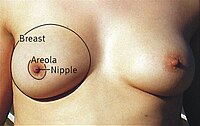
Association of Regional Intensity of Ductal Carcinoma In Situ Treatment With Likelihood of Breast Preservation
Sign Up to like & getrecommendations! Published in 2017 at "JAMA Oncology"
DOI: 10.1001/jamaoncol.2016.2164
Abstract: Importance Large regional variation exists in the use of radiotherapy after breast-conserving surgery (BCS) for ductal carcinoma in situ (DCIS). Although patients who do not receive initial radiotherapy for DCIS are candidates for subsequent BCS… read more here.
Keywords: use; seer; breast; dcis ... See more keywords

Mortality and survival patterns of childhood lymphomas: geographic and age‐specific patterns in Southern‐Eastern European and SEER/US registration data
Sign Up to like & getrecommendations! Published in 2017 at "Hematological Oncology"
DOI: 10.1002/hon.2347
Abstract: Childhood (0‐14 years) lymphomas, nowadays, present a highly curable malignancy compared with other types of cancer. We used readily available cancer registration data to assess mortality and survival disparities among children residing in Southern‐Eastern European… read more here.
Keywords: mortality survival; seer; registration data; age ... See more keywords

Sinonasal Mucosal Melanoma: A Population-based Comparison of the EUROCARE and SEER Registries
Sign Up to like & getrecommendations! Published in 2022 at "International Archives of Otorhinolaryngology"
DOI: 10.1055/s-0041-1740099
Abstract: Introduction Sinonasal melanomas are rare tumors with no comparative survival studies between Europe and the US. Objective To provide a population-based survival analysis between the two continents. Methods The European Cancer Registry (EUROCARE) and the… read more here.
Keywords: eurocare; age; population based; europe ... See more keywords

Interpreting Cancer Incidence Trends: Challenges due to the COVID-19 Pandemic.
Sign Up to like & getrecommendations! Published in 2023 at "Journal of the National Cancer Institute"
DOI: 10.1093/jnci/djad086
Abstract: The significant deficit in cancer diagnoses in 2020 due to COVID-19 pandemic disruptions in health care, can pose challenges in the estimation and interpretation of long-term cancer trends. Using SEER (2000-2020) data, we demonstrate that… read more here.
Keywords: incidence; due covid; covid pandemic; seer ... See more keywords

Gliomas of the Optic Nerve: A SEER-Based Epidemiologic Study
Sign Up to like & getrecommendations! Published in 2022 at "Journal of Neuro-Ophthalmology"
DOI: 10.1097/wno.0000000000001630
Abstract: Supplemental Digital Content is Available in the Text. Background: To determine whether patients with biopsy-confirmed optic nerve glioma differ in clinical features and outcomes from those diagnosed by neuroradiologic imaging alone. Methods: Retrospective comparative analysis.… read more here.
Keywords: biopsy confirmed; gliomas optic; optic nerve; pas gliomas ... See more keywords

Outcomes in patients with primary malignant cardiac tumors: A surveillance, epidemiology, and end results program (SEER) database analysis
Sign Up to like & getrecommendations! Published in 2021 at "Journal of Cardiac Surgery"
DOI: 10.1111/jocs.15725
Abstract: To the editor, We read with great interest the article by Torabi et al. which discusses outcomes with surgical and multimodality treatment in patients with primary cardiac sarcomas. The authors have done a remarkable job… read more here.
Keywords: seer; outcomes patients; analysis; seer database ... See more keywords

Abstract PD7-06: SEER study of breast cancer-specific mortality in patients with poorly differentiated tumors treated based on recurrence score results
Sign Up to like & getrecommendations! Published in 2017 at "Cancer Research"
DOI: 10.1158/1538-7445.sabcs16-pd7-06
Abstract: Introduction: The SEER Program of the NCI is an authoritative source of cancer incidence and survival statistics. Linking the 21-gene assay Recurrence Score® (RS) results to the SEER Registries (N=44,825) demonstrated very low 5-year breast… read more here.
Keywords: poorly differentiated; seer; breast cancer; differentiated tumors ... See more keywords

Unmet Medical Need Among Elderly Patients with Previously Untreated DLBCL Characterized Using Real-World Data in the United States
Sign Up to like & getrecommendations! Published in 2020 at "Blood"
DOI: 10.1182/blood-2020-136271
Abstract: Introduction: Diffuse large B-cell lymphoma (DLBCL) is a significant source of cancer morbidity and mortality. More than half of all newly diagnosed patients are older than 65 years, among whom the 5-year relative survival rate… read more here.
Keywords: research; seer; dlbcl; elderly patients ... See more keywords

Oncotype DX DCIS use and clinical utility: A SEER population-based study.
Sign Up to like & getrecommendations! Published in 2019 at "Journal of Clinical Oncology"
DOI: 10.1200/jco.2019.37.15_suppl.e12046
Abstract: e12046 Background: OncotypeDX DCIS is a 12-gene assay designed to predict the 10-year risk of local recurrence and to guide treatment decisions, specifically the benefit of radiation therapy in breast ductal carcinoma in situ (DCIS).… read more here.
Keywords: population; test; risk; seer ... See more keywords

S-GRAS score performs better than a model from SEER for patients with adrenocortical carcinoma
Sign Up to like & getrecommendations! Published in 2022 at "Endocrine Connections"
DOI: 10.1530/ec-22-0114
Abstract: Purpose To externally validate the performance of the S-GRAS score and a model from the Surveillance, Epidemiology, and End Results (SEER) database in a Chinese cohort of patients with adrenocortical carcinoma (ACC). Methods We first… read more here.
Keywords: patients adrenocortical; cohort; model; seer ... See more keywords

Clinicopathological characteristics and survival outcomes for testicular choriocarcinoma: a population-based study.
Sign Up to like & getrecommendations! Published in 2021 at "Translational andrology and urology"
DOI: 10.21037/tau-20-1061
Abstract: Background Due to the scarcity of cases of testicular choriocarcinoma (CC), its clinicopathological characteristics and prognosis have not been well summarized. Consequently, we conducted this population-based case-control study to characterize the features of testicular CC.… read more here.
Keywords: seer; population based; age; clinicopathological characteristics ... See more keywords